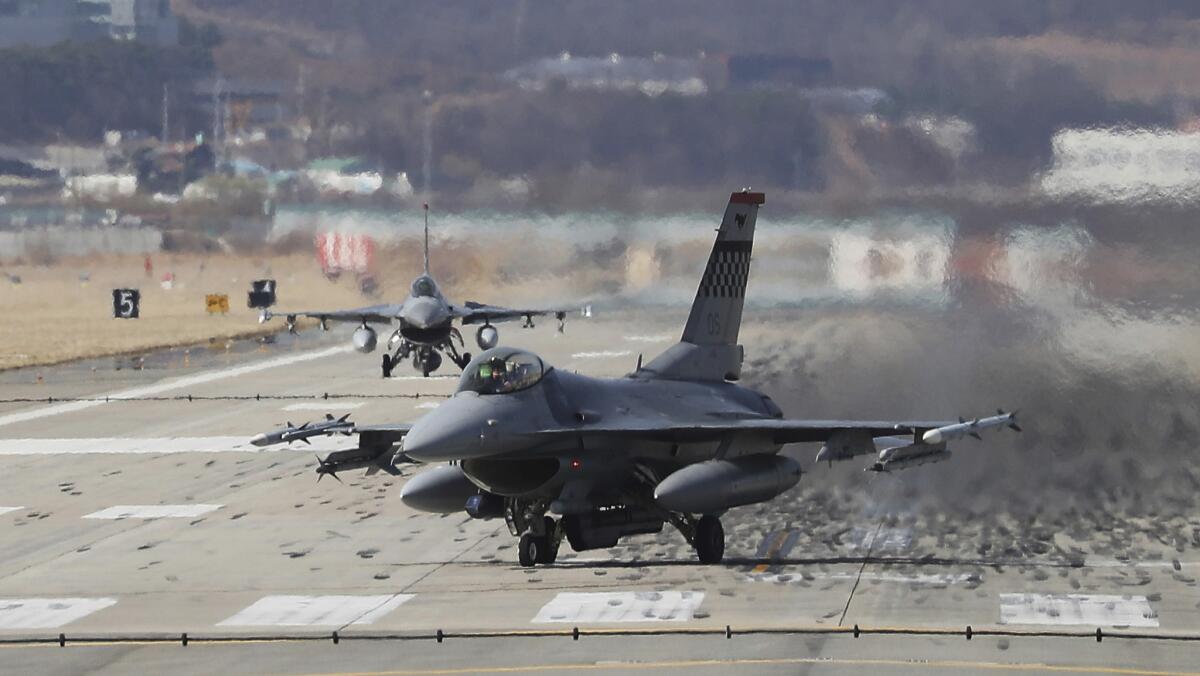Opinion: Trump shakedowns are threatening two key U.S. alliances in Asia

- Share via
The U.S. is moving toward a rupture with two important allies, South Korea and Japan. Already, President Trump has reportedly demanded a five-fold increase in the amount South Korea pays toward the cost of stationing U.S. forces there, raising the amount to $5 billion a year. Reports suggest that Washington is likely to seek a similar increase from Tokyo to support the cost of U.S. troops based there in next year’s negotiations.
For decades, Trump has derided America’s allies as “free-riders” who don’t pull their own weight. That is an inaccurate depiction of the large contributions provided to the U.S. by South Korea and Japan over the decades.
South Korea spends 2.6% of its gross domestic product on defense; that’s more than any of our European allies. By 2022, South Korea will be among the world’s top five or six highest spenders on defense. Seoul paid 92% of the $11-billion cost for building Camp Humphreys, the largest U.S. base on foreign soil, and over the last four years, South Korea has purchased $13 billion in arms from the United States.
South Korea has fought alongside the United States in every conflict since the Korean War. Seoul sent 300,000 troops to the Vietnam War, and 5,000 of its soldiers were killed. At one point, it fielded the third-largest troop contingent in Iraq after the United States and Britain. It has also conducted anti-piracy operations off Somalia and participated in peacekeeping operations in Afghanistan, East Timor and elsewhere.
Due to constraints imposed by the United States after World War II, Japan does not spend as large a percentage of its GDP on defense as South Korea. But Japan paid nearly all the cost of new U.S. military facilities at Futenma and Iwakuni, as well as a third of the cost of new facilities in Guam. Japan purchases 90% of its weapons and defense systems from the United States. While U.S. forces in Korea are focused on the North Korean threat, our forces in Japan are free to operate across half the globe.
Alliances are not valued in dollars and cents, and American service members are not mercenaries. Excessive U.S. monetary demands degrade alliances based on shared principles and goals into mere transactional relationships.
Trump’s actions are at odds with his administration’s strong advocacy of alliances, as detailed in the National Security and National Defense Strategies. Those documents stress how alliances magnify U.S. power, extend American influence and form the “backbone of global security.” Trump’s demands also run counter to the strong congressional and public support for these Asian alliances.
Cost-sharing negotiations are always contentious, but the current circumstances are especially fraught. The administration has made excessive demands in a combative manner, needlessly straining relations with Seoul just as North Korea is growing more bellicose. This is a time when allies should be standing shoulder to shoulder, not bickering over money.
A collapse of negotiations could cause Washington to withdraw some of its forces from the region. The U.S. could quickly reduce troop strength (currently at 28,000 troops) by 5,000 soldiers simply by not implementing the next rotational deployment of an Army combat brigade to South Korea. South Korean media reported the U.S. had threatened to do so, though this was denied by the Pentagon.
Drawing down U.S. forces before reducing the North Korean nuclear, missile and conventional threats would be a sign of weakness and would risk destabilizing the region and emboldening Pyongyang to take more provocative actions. It would also play into Beijing’s desire to reduce U.S. influence in the region. A troop drawdown would simply reinforce the negative signals sent by Trump’s arbitrary cancellation of military exercises on the Korean Peninsula, his troop redeployment in Syria and his acceptance of 24 North Korean missile launches this year in violation of U.N. sanctions.
The U.S. military presence in Asia has signaled Washington’s commitment to defend its allies and maintain peace and stability in the region. It has also enabled the U.S. to respond immediately to threats to its national interests. The Trump administration’s actions have already raised concerns in South Korea and Japan about the continuing viability of the United States as an ally.
To be sure, there are ways Japan and Korea both need to step up. Japan has made significant defense reforms in recent years, but more strides are needed to increase its defense spending and assume a greater security role in Asia, such as ensuring freedom of navigation in the South China Sea. South Korea needs to upgrade key parts of its communications systems to enable more effective war-fighting capabilities. Both allies also need to enhance security cooperation with each other. But these are issues that should be addressed in a joint strategy.
Instead, Trump is trying to shake down Seoul and Tokyo. The Trump administration needs to drop its unrealistic demands for massive increases in funding and shift instead to more moderate, incremental increases as part of a larger negotiation on roles, missions and capabilities needed to secure regional peace. The U.S.–South Korean alliance was forged in blood during the Korean War. Its enduring motto is katchi kapshida or “we go together.” The motto cannot become “we go together, if we are paid enough.”
Bruce Klingner is a senior research fellow at the Heritage Foundation. Jung Pak is a senior fellow at the Brookings Institution. Sue Mi Terry is a senior fellow at the Center for Strategic and International Studies.
More to Read
A cure for the common opinion
Get thought-provoking perspectives with our weekly newsletter.
You may occasionally receive promotional content from the Los Angeles Times.










